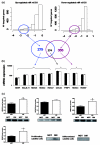Integration of microRNA changes in vivo identifies novel molecular features of muscle insulin resistance in type 2 diabetes
- PMID: 20353613
- PMCID: PMC2847700
- DOI: 10.1186/gm130
Integration of microRNA changes in vivo identifies novel molecular features of muscle insulin resistance in type 2 diabetes
Abstract
Background: Skeletal muscle insulin resistance (IR) is considered a critical component of type II diabetes, yet to date IR has evaded characterization at the global gene expression level in humans. MicroRNAs (miRNAs) are considered fine-scale rheostats of protein-coding gene product abundance. The relative importance and mode of action of miRNAs in human complex diseases remains to be fully elucidated. We produce a global map of coding and non-coding RNAs in human muscle IR with the aim of identifying novel disease biomarkers.
Methods: We profiled >47,000 mRNA sequences and >500 human miRNAs using gene-chips and 118 subjects (n = 71 patients versus n = 47 controls). A tissue-specific gene-ranking system was developed to stratify thousands of miRNA target-genes, removing false positives, yielding a weighted inhibitor score, which integrated the net impact of both up- and down-regulated miRNAs. Both informatic and protein detection validation was used to verify the predictions of in vivo changes.
Results: The muscle mRNA transcriptome is invariant with respect to insulin or glucose homeostasis. In contrast, a third of miRNAs detected in muscle were altered in disease (n = 62), many changing prior to the onset of clinical diabetes. The novel ranking metric identified six canonical pathways with proven links to metabolic disease while the control data demonstrated no enrichment. The Benjamini-Hochberg adjusted Gene Ontology profile of the highest ranked targets was metabolic (P < 7.4 x 10-8), post-translational modification (P < 9.7 x 10-5) and developmental (P < 1.3 x 10-6) processes. Protein profiling of six development-related genes validated the predictions. Brain-derived neurotrophic factor protein was detectable only in muscle satellite cells and was increased in diabetes patients compared with controls, consistent with the observation that global miRNA changes were opposite from those found during myogenic differentiation.
Conclusions: We provide evidence that IR in humans may be related to coordinated changes in multiple microRNAs, which act to target relevant signaling pathways. It would appear that miRNAs can produce marked changes in target protein abundance in vivo by working in a combinatorial manner. Thus, miRNA detection represents a new molecular biomarker strategy for insulin resistance, where micrograms of patient material is needed to monitor efficacy during drug or life-style interventions.
Figures



References
-
- Mootha VK, Lindgren CM, Eriksson KF, Subramanian A, Sihag S, Lehar J, Puigserver P, Carlsson E, Ridderstrale M, Laurila E, Houstis N, Daly MJ, Patterson N, Mesirov JP, Golub TR, Tamayo P, Spiegelman B, Lander ES, Hirschhorn JN, Altshuler D, Groop LC. PGC-1alpha-responsive genes involved in oxidative phosphorylation are coordinately downregulated in human diabetes. Nat Genet. 2003;34:267–273. doi: 10.1038/ng1180. - DOI - PubMed
-
- Patti ME, Butte AJ, Crunkhorn S, Cusi K, Berria R, Kashyap S, Miyazaki Y, Kohane I, Costello M, Saccone R, Landaker EJ, Goldfine AB, Mun E, DeFronzo R, Finlayson J, Kahn CR, Mandarino LJ. Coordinated reduction of genes of oxidative metabolism in humans with insulin resistance and diabetes: Potential role of PGC1 and NRF1. Proc Natl Acad Sci USA. 2003;100:8466–8471. doi: 10.1073/pnas.1032913100. - DOI - PMC - PubMed
LinkOut - more resources
Full Text Sources
Other Literature Sources
Molecular Biology Databases

